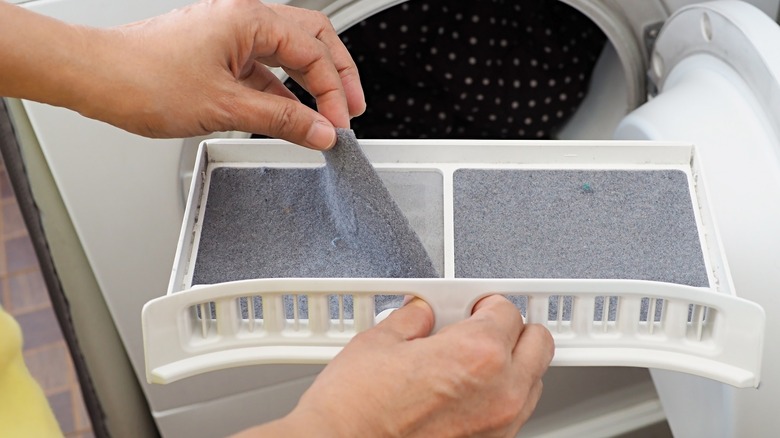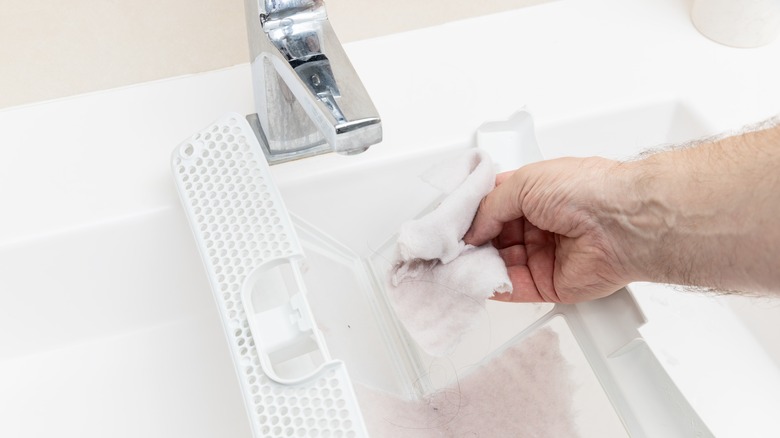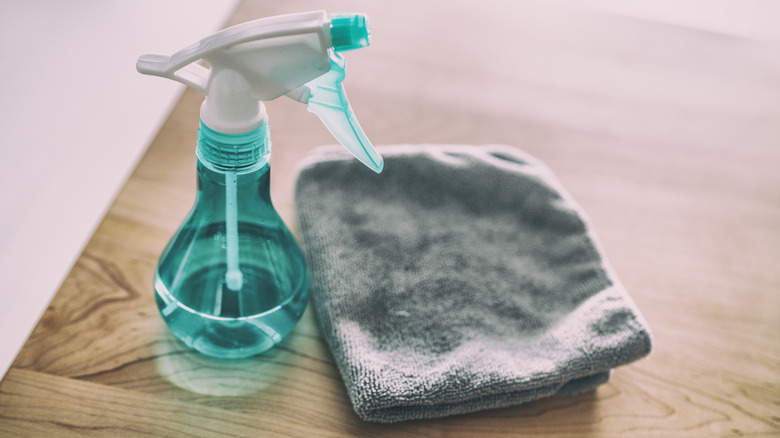Using Hydrogen Peroxide To Clean A Dryer's Lint Trap: Good Idea Or Safety Hazard?
The importance of washing and drying laundry for sanitary purposes is rarely questioned by modern society. However, the cleanliness of the machines that are used to wash and dry our clothing, bedding, and towels is rarely addressed. Beyond removing the lint that gathers in the trap, many people are unsure of what they can do to keep their dryer's lint trap clean and sanitary. It's important to deeply clean the lint trap regularly, as small pieces of debris that can't be removed with your fingers could lead to less-dry clothes or a damaged appliance. You may have wondered if water is enough to sanitize a dirty lint trap or if bleach is safe to use in an appliance that reaches high temperatures. On the other hand, perhaps you've pondered if cleaning with hydrogen peroxide is a good choice.
With its lack of strong fumes and disinfectant properties, hydrogen peroxide seems like an excellent product for deeply cleaning a dryer's lint trap — and that it is. However, according to the Agency for Toxic Substances and Disease Registry with the CDC, while it is non flammable, this liquid can lead to spontaneous combustion under certain circumstances. Fortunately, everything required to remove this risk has already been done for you before you purchase a bottle of hydrogen peroxide. Consider this your guide to safely using hydrogen peroxide (and other DIY cleaning solutions) to clean and disinfect your dryer's lint trap.
How to clean your lint trap with hydrogen peroxide
Cleaning your lint trap using hydrogen peroxide is safe when using commercial bottles of the substance. Since hydrogen peroxide is only at risk of combustion at high concentrations, it is diluted before it is sold to consumers. The average brown bottle of this liquid that's sold in drugstores and supermarkets contains 3% hydrogen peroxide and 97% water, making it perfectly suitable for applying directly to your dryer's lint trap. However, when using this substance, keep in mind that it can cause eye, throat, and skin irritation, so don't breathe it in for too long or get the liquid on your skin.
To clean this part of your dryer with hydrogen peroxide, remove any lint you can grasp from the trap and then spray or pour on a small amount of peroxide. Scrub both sides of the lint trap with a damp sponge or brush. Then, rinse the trap thoroughly with warm water to remove any remaining peroxide. If it appears to be clogged or coated with debris, repeat the process. If you use optional laundry products like dryer sheets, it may take several cleanings to remove all the residue. Once the trap is clean, soak up any excess water with a paper or cloth towel. Finally, allow the trap to completely air dry before returning it to the dryer.
Other methods for DIY lint trap cleaning
While hydrogen peroxide is perfectly safe to use for cleaning your dryer's lint trap, that doesn't necessary mean that you have any on hand. If your lint trap needs to be deep cleaned and you don't happen to have any peroxide lying around, there are other ways to make a DIY cleaning solution that is suitable for use on your trap. First, consider trying a simple rinse with warm water, then allow it to dry completely. This is the method dryer manufacturers like LG recommend (via LG USA Support on YouTube).
If you feel like your lint trap requires more than water to be cleaned properly, simply add a few drops of laundry detergent or bleach to a spray bottle and fill the rest with water. Spray, scrub, rinse, repeat if necessary, and dry just as you would with a peroxide solution before returning it to the dryer. Most recommend deeply cleaning your lint trap with water, hydrogen peroxide, or another cleaner twice a year, though keep in mind that you should always remove lint after every single use.


